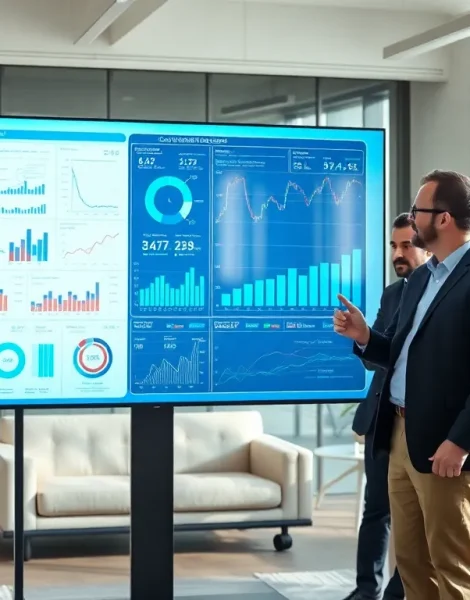In today’s fast-paced world, businesses are like roller coasters—full of ups, downs, and unexpected twists. Enter transition analytics, the superhero of data that swoops in to save the day. This powerful tool helps organizations navigate change with precision, turning chaos into clarity. It’s like having a GPS for your business journey, ensuring you never take a wrong turn.
As companies evolve, understanding the nuances of transitions becomes crucial. Transition analytics provides the insights needed to make informed decisions, optimize processes, and ultimately boost performance. Imagine having the ability to predict outcomes and adapt strategies in real time. Sounds like magic, right? Well, it’s just good data at work. Dive into the world of transition analytics and discover how it can transform your organization from a bumpy ride into a smooth sailing adventure.
Table of Contents
ToggleOverview of Transition Analytics
Transition analytics serves as a crucial tool for businesses navigating change. This data-driven method reveals valuable insights and enhances decision-making for organizations.
Definition and Scope
Transition analytics involves the analysis of data to manage and predict organizational changes. It encompasses various stages from initial assessment to the implementation of strategies. Organizations leverage transition analytics to identify key performance indicators, assess risks, and evaluate market dynamics. This process ultimately supports informed decision-making throughout the transformation journey.
Importance in Modern Business
Modern businesses rely heavily on transition analytics for several reasons. Firstly, it promotes agility, allowing organizations to adjust strategies based on real-time data. Enhanced performance tracking leads to improved outcomes, reducing the likelihood of missteps during transitions. Additionally, understanding customer behaviors through this approach helps tailor services and products to meet evolving needs. Ultimately, companies that embrace transition analytics find themselves better prepared for unexpected challenges and competitive pressures.
Key Components of Transition Analytics

Transition analytics comprises several key components that play crucial roles in effective organizational change. Understanding these elements is essential for maximizing the benefits of transition analytics.
Data Collection and Integration
Data collection and integration are fundamental aspects of transition analytics. Organizations gather various data types, including operational, financial, and customer-related information. This process ensures that all relevant data sources are unified, creating a comprehensive view of the organization’s current state. Integrating these data sets allows for more accurate assessments of performance metrics. Companies often use automated tools to streamline data collection, enhancing efficiency. High-quality, well-integrated data forms the backbone of insightful analyses. Effective integration supports seamless access to critical information, enabling informed decision-making across departments.
Analytical Models and Tools
Analytical models and tools are vital for turning raw data into actionable insights. Various methodologies are employed, such as predictive analytics, which forecasts future trends based on historical data. Organizations apply tools like data visualization software to interpret complex data sets effectively. These tools allow for real-time analysis, crucial during transitions. Predictive modeling helps identify potential risks and opportunities, guiding strategic decisions. Implementing machine learning algorithms can uncover patterns that traditional analyses might overlook. Ultimately, powerful analytical models enhance organizations’ ability to adapt and respond to dynamic market conditions.
Applications of Transition Analytics
Transition analytics plays a crucial role across various industries by optimizing processes during organizational changes. This capability enables businesses to align their strategies with market demands effectively.
Industry-Specific Uses
Healthcare organizations utilize transition analytics to enhance patient care. By analyzing operational data, these institutions identify bottlenecks and streamline workflows for better service delivery. In retail, companies leverage transition analytics to optimize inventory management. Tracking customer behavior trends allows businesses to adjust stock levels according to demand fluctuations. Financial services benefit from this approach too, as firms predict market shifts and tailor investment strategies accordingly. Analyzing customer data helps them mitigate risks and seize opportunities for growth.
Case Studies and Success Stories
Numerous success stories illustrate the impact of transition analytics. A leading telecommunications company improved customer retention rates by 20% after implementing analytics to track service usage patterns. This analysis enabled targeted marketing efforts, resulting in higher customer satisfaction. Another retail giant reported a 30% reduction in excess stock due to insights gained from transition analytics. By accurately predicting sales trends, they adjusted purchasing strategies, leading to financial savings. A global logistics provider successfully reduced delivery times by 15% through data-driven route optimizations, showcasing the power of transition analytics in enhancing operational efficiency.
Challenges and Considerations
Transition analytics presents several challenges that organizations must navigate. Data privacy and security issues often emerge as primary concerns. Organizations collect sensitive operational, financial, and customer-related data. Robust measures must protect this data from breaches. Compliance with regulations like GDPR and CCPA remains crucial. Failing to implement strong security protocols can result in significant legal and financial repercussions.
Implementation obstacles arise as another important consideration. Many organizations face difficulties integrating existing systems with new analytics tools. Legacy systems can hinder functionality, delaying data flow and insights. Additionally, staff may require training on new software, impacting productivity during the transition phase. Resistance to change from employees can also present a significant barrier. Engaging stakeholders early and providing adequate training enhances adoption rates. Timely identification of these obstacles allows organizations to implement effective strategies and minimize disruptions.
Future Trends in Transition Analytics
Transition analytics is evolving with emerging technologies and data-driven methodologies driving its future. Organizations embrace these advancements to enhance decision-making and streamline transformation processes.
Emerging Technologies
Emerging technologies like the Internet of Things (IoT) and blockchain are reshaping transition analytics. IoT devices generate vast amounts of real-time data, which organizations analyze to gain insights into operations and customer behaviors. Blockchain ensures data integrity and transparency, making the analytics process more reliable. Furthermore, cloud computing enables organizations to access and analyze data from anywhere, supporting remote teams and improving collaboration. As these technologies mature, organizations will increasingly leverage them to improve data accuracy and enhance the real-time capabilities of transition analytics.
Predictive Analytics and AI
Predictive analytics and artificial intelligence play a significant role in the future of transition analytics. Organizations utilize predictive models to anticipate future trends and challenges based on historical data. Machine learning algorithms enhance these models by refining predictions as more data becomes available. Consequently, organizations can implement proactive strategies to mitigate risks and seize opportunities. These technologies improve efficiency during transitions by automating routine analytics tasks, freeing up teams to focus on critical decision-making. As predictive analytics and AI continue to advance, their integration into transition analytics will drive greater innovation and agility across industries.
Transition analytics stands as a crucial asset for organizations aiming to thrive amid change. By leveraging data effectively, businesses can navigate complexities and enhance their operational agility. The integration of advanced technologies continues to reshape how organizations approach transitions.
As they adapt to evolving market conditions, the insights gained from transition analytics empower leaders to make informed decisions and mitigate risks. This proactive stance not only streamlines processes but also fosters innovation and resilience. Embracing transition analytics is no longer optional; it’s essential for any organization seeking to maintain a competitive edge in today’s fast-paced landscape.









